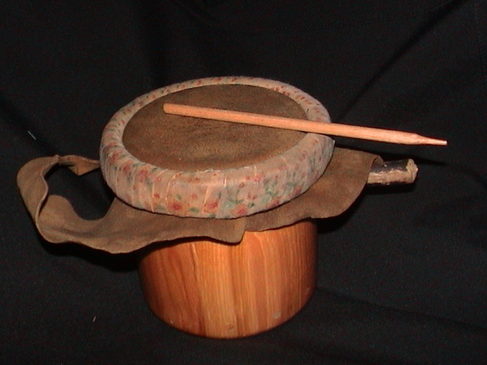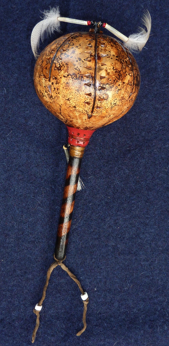When the Pilgrims landed at Plymouth, the Native American Wampanoag tribe kindly showed the settlers how to farm the land, hunt and fish, and adapt to life in the new world. In 1621, when the Pilgrims harvested their first crop, the Wampanoags brought food to celebrate with them. This Thanksgiving, let’s give thanks to the Wampanoag people and celebrate their rich music culture.
The Role of Music in Wampanoag Culture
For the Wampanoag tribe, music is an essential part of everyday life. It is used for ceremonies, recreation, expression, healing, spirituality, and passing down history.
Songs serve many purposes, from invoking spirits, to asking for rain, luck, or guidance, to healing the sick. Songs are also used to pass down history, tell stories or explain the reason for a ceremony or ritual.
There are courtship songs, dancing songs, thanksgiving songs, and songs that celebrate the harvest, planting season, or other important times of year.
Tribal flag songs and national anthems are often used to start public ceremonies or gatherings.
Some songs are only used in private for sacred or ceremonial purposes. These secret songs have special significance and are believed to have come from spirits, deities, or people who are particularly respected within the tribe, such as spiritual leaders.
Music and history are tightly interwoven for the Wampanoag people. Music is a medium for telling tribal history and passing oral traditions down to future generations. With the addition of dance, epic stories and legends can be acted out in a truly inclusive and dynamic celebration of the Wampanoag tribe’s beliefs and traditions.
Musical Style
Wampanoag music shares many characteristics with other indigenous tribes.
Musical styles can be divided into different regional areas: Eastern Woodlands, Plains, Southwest, Great Basin, Northwest Coast, and Arctic. The Wampanoag tribe is part of the Eastern Woodlands style.
Throughout all Native American musical traditions, voice and percussion play the most important roles.
The voice is used in many different ways, from solo and choral singing to call and response, unison and multipart singing. The singing is somewhat off-key and there is little to no use of harmony. The vocal style is passionate and often includes meaningless syllables, called vocables. Vocables frequently mark the beginning and end of phrases or separate different sections of a song.
Percussion instruments are commonly used as accompaniment to keep the rhythm steady for the singers. Native American music is strongly tied to ritual dance, which also informs the rhythmic style.
As part of the Eastern Woodlands area, Wampanoag music shares style elements with other Eastern Woodlands tribes that are not found in other areas.
In this tradition, songs are rhythmically complex. There are short repetitive phrases, shouts before, during and after singing and frequent metric changes. There is frequent use of call and response singing, also called antiphony. The singing usually slowly descends in pitch and is marked by pulsations and tension. The tensing and releasing of the voice in combination with changing drum beats makes this music a very intricate and complex art form.
Instruments
Drums, rattles, whistles and flutes are some of the most important instruments for all Native American music. However, these instruments vary greatly from tribe to tribe. We will explore the Wampanoag variations of these instruments.
Water Drum
The Wampanoag water drum is small and can easily be held in one hand. It is made from a hollowed-out piece of wood covered with deer hide.
Traditionally, it was made by burning out the inside of a tree trunk that was approximately six inches tall. Wet deerskin was stretched over the top of the hollowed-out piece of wood and attached by a ring that fit firmly around the skin and the opening in the wood.
A small hole was made in the side of the drum to insert a peg. The performer could remove to peg to fill the drum with water. The amount of water and the tightness of the deerskin would then adjust the pitch and sound.
Check out what a water drum sounds like.

Rattles
Gourd Rattle
The Wampanoag gourd rattle is made from a hollowed-out dried gourd. It is filled with small stones or dried corn and plugged with corncobs. If the rattle is to be used in a healing ceremony, the healer can add other personal items of spiritual significance.

Turtle Shell Rattle
The turtle shell rattle was traditionally made by placing a turtle carcass on an anthill. The ants would eat the turtle meat, completely hollowing it out. The legs were sewn shut and the neck was stretched out with a piece of wood. The carcass was then filled with pebbles, shells and other objects that would create the desired sound.
Deer Leg Rattle
The deer leg rattle is made from the lower portion of a deer leg. The leg bone is used as a handle and deer toe bones and hooves are attached to the end. Deer leg rattles can also be tied to a dancer’s legs to create a rhythm while dancing.


Bone Whistle
Wampanoag bone whistles are usually made from hollow bird bones and are used strictly as sacred items in ceremonies.
Flute
The Wampanoag flute is typically made from cedar or cane. It has a channel carved into the top. Its sound is strong and clear and it is very easy to play, even for a beginner.
There are many variations of the flute throughout different tribes. For example, the flute usually has five or six holes, but it could have up to nine holes and sometimes no holes at all. Similar to other Native American flutes, the Wampanoag flute has two chambers, which give it its distinct sound.
The flute is made using measurements from the human body. It is considered a spiritual instrument and is commonly used in courtship, meditation, healing ceremonies, and other spiritual rituals.


The Wampanoag musical tradition is truly inspirational. It brings people together and keeps their rich history alive. Learning about their music and its important role in their culture shows us just how much music can enrich us all. The Wampanoag people have their own thanksgiving music that they use to express gratitude. Let’s thank them for passing on the gift of some very special music. Have a happy and musical Thanksgiving!
Below are some videos of Wampanoag music. Enjoy.
Wampanoag Powwow Music
Wampanoag Nation Singers and Dancers
Wampanoag Sacred Spirit Song
Ready to learn music?
Start learning with our 30-day free trial! Try our courses now!About Liberty Park Music
LPM is an online music school. We teach a variety of instruments and styles, including classical and jazz guitar, piano, drums, and music theory. We offer high-quality music lessons designed by accredited teachers from around the world. Our growing database of over 350 lessons come with many features—self-assessments, live chats, quizzes etc. Learn music with LPM, anytime, anywhere!


SALVE .. LOVE THESE TREASURES A LOT !😁👍💗
Thank you! We’d suggest bookmarking the page to re-visit whenever nostalgia hits.
This gave me a lot of information and thank the god for education 😀;-)